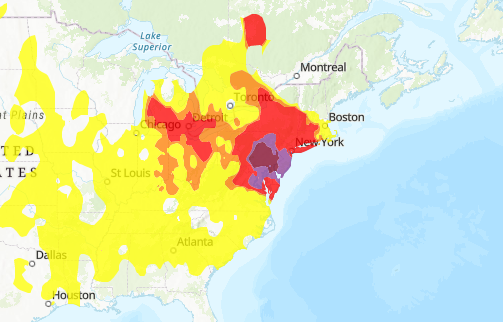The dangers of wildfire air pollution
June 11, 2023
The past six weeks have brought intense wildfires across Canada, burning across an area larger than the state of Maryland. This wildfire season in Canada has been far more intense than any other wildfire season that they have experienced, outpacing other years by a large margin. Experts say that climate change-driven high temperatures and drought is creating tinderbox-type conditions. Lytton, British Columbia, reached the highest temperature found in Canada at 121 Fahrenheit last month.
The smoke from these fires has drifted down from the Quebec province, covering the East Coast from New York to South Carolina in a thick blanket of pollution. Levels of PM2.5 particles, which are fine, 2.5 microns sized (around 5% the width of the human hair) mixtures of harmful gaseous pollutants have skyrocketed across the coast. New York City reached a level about one-third higher than its previous highest level of PM2.5 (Washington Post). Virginia Beach has similarly been affected, if not to that level. Extending into the 150s on the Air Quality Index (for more information, go to Airnow.gov), a thick level of smoke has covered the skies , partly concealing the Town Center skyline.
This smoke can be a great detriment to the health of all residents, as wildfire aerosols are 10 times more harmful than standard pollution. But, they have an even increased effect on young children (including teens), pregnant women, those with respiratory illnesses like long COVID or asthma, and elderly adults. Children are more susceptible because of many reasons: the amount of PM2.5 entering their lungs is higher due to an increased breathing rate, smaller and developing lungs, and more time spent outside, according to Science News Explores.
Minor effects of the smoke can range from headaches to sinus, eye, and throat irritation and tightness in the chest. These are indicators that your body creates to tell you to get away from the source of irritation in the smoke. These minor symptoms usually take a few days to exit from your system.
As for long-term effects, there is evidence that wildfire pollution may be able to weaken the immune system, according to research from the Journal of Allergy and Clinical Immunology. Particles under 10 microns in diameter are able to penetrate into the lungs and sometimes into the bloodstream, affecting the lungs and heart, leading to an increased risk for respiratory and cardiovascular diseases.
To protect yourself from wildlife pollution, try to reduce the time that are exposed to smoke, turn on the air conditioning or air filters, or wear an N95 mask. Surgical masks do not work because they are not able to filter particulate matter attempting to enter into the mask, while the N95 has a 95% filtration rate.




